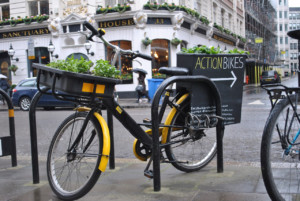What London Taught Us About Cycling in the Netherlands
 In recent years, Mobycon staff have traveled to the UK to explore ways to improve safety for vulnerable road users. This spring Mobycon staff Oliver Blake went to London for two weeks to conduct ethnographic research on London’s bicycle culture. We wanted to look past the numbers and begin to understand what every day cycling in London is like. Here are some excerpts of the study. Many readers may find some parallels in their part of the world.
In recent years, Mobycon staff have traveled to the UK to explore ways to improve safety for vulnerable road users. This spring Mobycon staff Oliver Blake went to London for two weeks to conduct ethnographic research on London’s bicycle culture. We wanted to look past the numbers and begin to understand what every day cycling in London is like. Here are some excerpts of the study. Many readers may find some parallels in their part of the world.
From cyclist to pedestrian in no more than 30 seconds
In the Netherlands, the relationship between pedestrian and cyclist is fluid, people easily switch between the two modes. This is how I normally get off my bike: “Nearing my destination, I ride up a lowered curb onto the pavement. As I come to a stop I dismount my bike, kick down the stand and balance it upright. Before I head on my way, I reach down for the keys hanging from the back wheel lock, turn them clockwise and push down the lever to secure my bike. After this, I’m off amongst the crowd. From cyclist to pedestrian in no more than 30 seconds.”
As it turns out, things are not quite as simple in London: “I spotted a café to stop and write up some notes. I continued down the street looking for a place to lock my bike. About 30 meters ahead I came across a bike rack on the pavement. I leant my bike against the railing, unclipped my helmet and put it down, unscrewed my detachable bike lights and removed my phone mount, putting both in my bag. I removed my cable from my bag which accompanied the D-Lock needed to lock both wheels. Finally, I took my keys out my pocket and fastened my bike to the railing. I headed back down the street to café. Around four or five minutes had passed since I’d decided to stop.”

Hi-Viz clothing
The switch from bike to foot takes a lot longer in London for two main reasons. The first is equipment. In the UK it’s commonplace to see people on bikes with helmets, high-vis clothing and other special cycling equipment. Each piece of equipment is an extra layer to remove or apply before and after a journey. In the Netherlands the way people dress to ride a bike is no different from what they would wear to sit in an office, go to a bar or head to the cinema.
Convenient kickstand
The second reason is parking and locking. In London it is unusual to see bikes with kick stands, a common feature here in the Netherlands. This simple device affords a high level of flexibility over where to park. Without this feature you need to find something to lean your bike against. Another feature that is rare in the UK is the back wheel lock. In my account in London, I mentioned having to take my keys from my pocket, with a back-lock you don’t even have to do this as your keys remain in the lock while unlocked. These two features allow a simple transition from cyclist to pedestrian, creating a fluid and flexible relationship.
Bike as a choice of convenience
But what does this mean for London’s cycling ambitions? Well, for starters, it makes the bike seem a more awkward choice than it is in the Netherlands, with added considerations over what equipment is necessary and where is a suitable place to park. Not to mention extra time spent after a journey locking and removing accessories. The bike is a choice of convenience in the Netherlands and the way people can seamlessly switch between walking and cycling adds to its ease. Perhaps once bikes become more normal and people feel safe to cycle, there will be less of a need for extra cycling equipment and clothing on the streets of London. You might even see some more Dutch bikes in cycle lanes and parked on their kickstands.
Enthusiastic stakeholders
To wrap up the research, I travelled back to London and presented my findings to enthusiastic stakeholders. But I didn’t just want to tell Londoners what cycling in London was like. Colleague Angela van der Kloof related my findings to Dutch transport ideas.
Over the course of my stay, I cycled 350km/220 miles and interviewed 25 people. Now the staff at Mobycon can approach work in London with a rounded understanding of London’s cycle culture, political context and geography.
When I set off I didn’t expect to learn anything about cycling in the Netherlands – but that’s exactly what happened!
If you want to know more about bicycle cultures in London, UK and the Netherlands, contact o.blake@Mobycon.com

